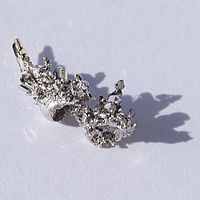
Photo from wikipedia
Direct catalytic decomposition is a promising technology to control the emission of nitrous oxide (N2O) during fossil fuel combustion and various chemical industries. In this study, a series of NiO… Click to show full abstract
Direct catalytic decomposition is a promising technology to control the emission of nitrous oxide (N2O) during fossil fuel combustion and various chemical industries. In this study, a series of NiO catalysts modified with different metal oxides (MaNiOb) were prepared by the co-precipitation method and employed for the direct catalytic decomposition of N2O. Bismuth (Bi) species was confirmed to be the most optimal promoter and the Bi0.1NiO1.15 catalyst with a Bi/Ni molar ratio of 0.1 exhibited the best activity over the temperature range of 300-450 °C. The addition of Bi species also promoted the steam resistance capability of the NiO catalyst. Moreover, the physicochemical properties of pure and Bi-modified NiO catalysts were further determined by several characterization methods. The surface areas and capacity of oxygen adsorption/desorption over the catalyst were noticeably improved with the doping of Bi species. Besides, the presence of doped-Bi facilitated the creation of both Ni3+ and surface oxygen vacancies on NiO, which promoted the performance of N2O decomposition. Whereas, the excessive Bi species would accumulate to form large Bi2O3 grains, which diminished the surface areas and covered the active sites on the catalysts, leading to the rapid degradation of N2O catalytic decomposition.
Journal Title: Journal of hazardous materials
Year Published: 2020
Link to full text (if available)
Share on Social Media: Sign Up to like & get
recommendations!